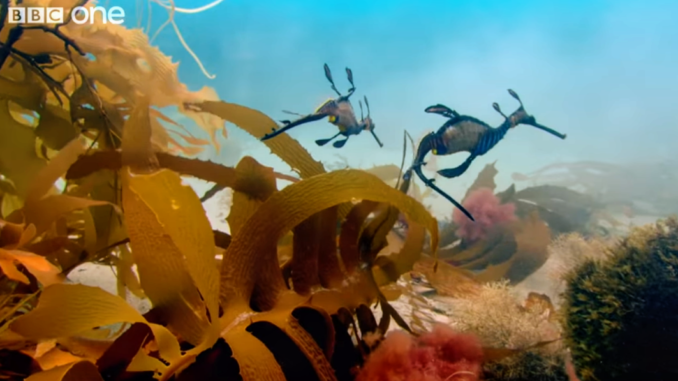
Seadragons, seahorses, and pipefish have a few things in common. For starters, they are all part of the Syngnathidae family. It’s easy to see the family resemblence in their faces: they all have long, narrow, fused jaws which makes it look as if they have to sip their meals through a straw. (Of course, the seahorse has a shorter beak than seadragons and pipefish, but that’s only because they drew the short straw. j/k.) Another thing they have in common is the rhetorical question asked about them, “Are you sure that’s a fish?” Yes, they actually are fish. Living things come in an amazing variety of forms, and even creatures that are closely related to each other can look completely different.
Phyllopteryx taeniolatus, known colloquially as the common seadragon or the weedy seadragon, is found along the southern coasts of Australia and the island of Tasmania. They are endowed with natural camouflage in the form of leafy ‘accessories’ similar to kelp fronds, allowing them to blend in and hide among kelp from predators. These frond-like appendages have nothing to do with locomotion. A dorsal fin along the length of their back provides slow and gentle propulsion, the better to blend in with the kelp. Hiding in plain sight, rather than fast swimming, is the survival strategy for these fish. Wild seadragons can live as long as six years and grow up to 45 cm (17 inches) in length. As with seahorses, the female seadragon deposits her eggs on the male’s brood patch located on his tail. The male then fertilizes the eggs and carries them for about a month, at which time they hatch and immediately begin hunting for food on their own. In 28 months, the few young hatchlings that survive will be old enough to mate.
Scientific Classification
Kingdom: Animalia
Phylum: Chordata
Class: Actinopterygii
Order: Syngnathiformes
Family: Syngnathidae
Genus: Phyllopteryx
Species: P. taeniolatus
Binomial name: Phyllopteryx taeniolatus
(Lacepède, 1804)
“Life – Weedy seadragons dance into the night – BBC One” (3:36)
